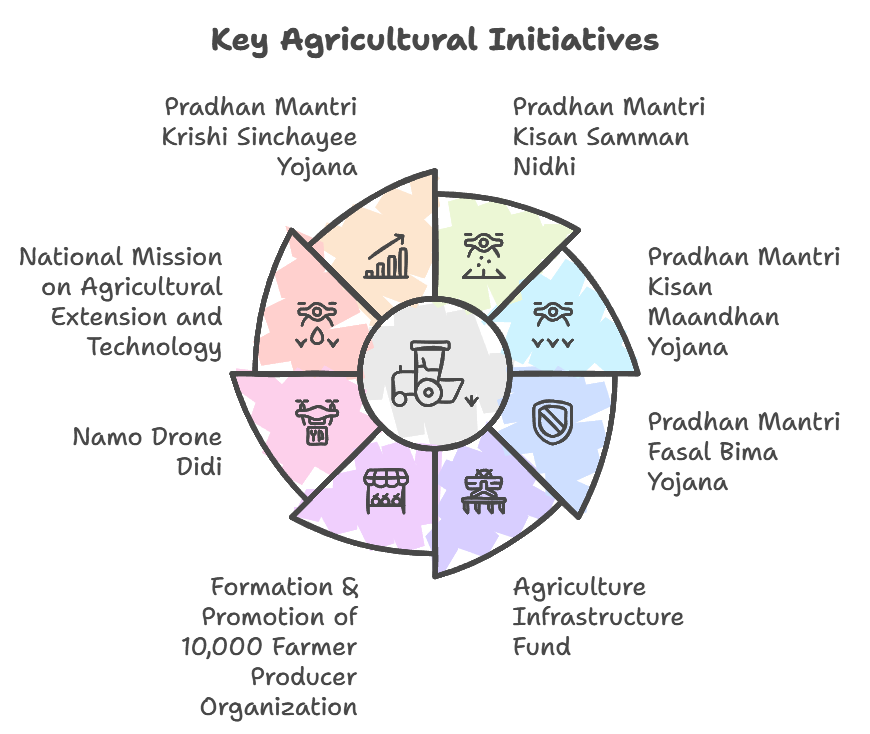-
Q. Agriculture is a vital sector for India’s economy but faces several challenges. Discuss these challenges and propose measures to address them. (250 words)
09 Apr, 2025 GS Paper 3 EconomyApproach
- Briefly introduce the significance of Indian agriculture for the Economy.
- Discuss the challenges Indian agriculture is facing and suggest measures to address them.
- Conclude suitably.
Introduction
Agriculture is the backbone of India’s economy, contributing about 17-18% of India’s GDP and sustains over 60% of the rural population. However, despite its importance, the sector faces several structural and operational challenges that hinder its growth and sustainability.
Body
Challenges Facing Indian Agriculture
- Productivity and Fragmentation of Land: Agricultural productivity in India is hindered by outdated farming practices and limited mechanization.
- Land fragmentation, driven by inheritance laws,(average size of landholdings has reduced from 2.28 hectares in 1970-71 to 1.15 hectares in 2015-16), making it difficult for farmers to achieve economies of scale or access modern technologies.
- Inadequate Access to Credit: Farmers, especially small and marginal ones, often face limited access to formal credit due to stringent collateral requirements and lack of financial literacy.
- Crop insurance schemes like the Pradhan Mantri Fasal Bima Yojana (PMFBY) have been underutilized due to lack of awareness, delayed claims, and low coverage.
- Dependence on Monsoon: Indian agriculture is highly dependent on the monsoon rains, which are erratic and unevenly distributed. A delay or failure of monsoon causes crop failures, water scarcity, and a rise in agricultural distress.
- Price Fluctuations: Market access remains a significant challenge, particularly for small farmers who are often subject to middlemen exploitation in mandis or face high transportation costs.
- Price volatility due to poor storage and market linkages leaves farmers vulnerable to low prices during harvest and high prices in off-season.
- Lack of Infrastructure: Inadequate rural infrastructure such as storage facilities, and cold chains affects the supply chain and prevents timely delivery of produce to markets. Post-harvest losses are high due to lack of modern storage and processing facilities.
Measures to Address Challenges in Indian Agriculture
- Diversification and Crop Insurance: Promote crop diversification to reduce the dependency on a single crop and mitigate risks associated with weather and price fluctuations.
- Strengthen and expand crop insurance schemes like PMFBY, increase the coverage of weather-indexed insurance schemes.
- Simplify the Kisan Credit Card (KCC) scheme and promote awareness about easy loan facilities.
- Promoting Farm Mechanization: Introduce mechanization (e.g., tractors, harvesters, drones for precision farming) to increase productivity and reduce labor costs.
- Provide training to farmers through Dedicated Agriculture Engineering on the use of modern agricultural practices and technology.
- Land Reforms and Consolidation: Encourage the use of contract farming models and Farmer Producer Organizations (FPOs), which can help small farmers pool their resources, and negotiate better prices.
- Strengthening Agricultural Markets: Establish more Farmer Producer Markets (FPMs) and direct-to-consumer models and policies that encourage value-added products (organic food) to reduce the dependence on intermediaries and ensure better prices for farmers.
- Strengthen the Minimum Support Price (MSP) system to ensure fair prices for essential crops, thus reducing farmers' dependence on market fluctuations.
- Sustainable Agriculture: Encourage rainwater harvesting, efficient irrigation technologies (e.g., drip irrigation, sprinkler systems) to reduce dependency on rainfall.
- Shift towards organic farming and the use of bio-fertilizers to ensure long-term soil health and reduce the negative environmental impact.
Conclusion
By improving access to finance, modernizing farming techniques, and strengthening market linkages, we can ensure that agriculture becomes more resilient, productive, and profitable for farmers. The government’s role in creating an enabling environment for farmers through policies, infrastructure development, and financial support will be crucial to achieving agricultural transformation.
To get PDF version, Please click on "Print PDF" button.
Print PDF





